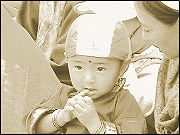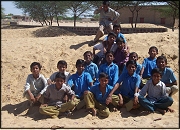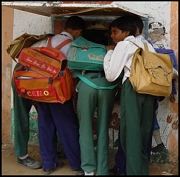
|

|
||||||||||||||||||||||||||||||||
|
|||||||||||||||||||||||||||||||||
|
Education Challenge
The Education Imperative
Education as a Millennium Development Goal With this in mind the United Nations adopted education as one of the eight objectives of the Millennium Development Goals (MDG) defined by the United Nations. Goal 2 of the MDG, “Achieve universal primary education,” is also the most fundamental. Other MDGs of poverty reduction, gender equality and healthcare can only be sustained when today’s children grow up to be educated citizens. The goal of universal primary education also is the only goal that has a 100% target—a fact that emphasizes the importance of the goal. The target for this Goal is: “To ensure by 2015 that all children complete a full course of primary schooling.” Is the world on track to achieve this goal? To answer this question, we need to look at it from the following perspectives: • Spending required to achieve the goal • Relationship between spending and outcomes • Rate of progress needed From the point of view of public spending to achieve the goal of universal primary education, the goal does seem achievable. However, several recent studies indicate that the “link between educational outcomes and public education resources is at best weak.” Quality of Education Of particular concern is outcome with respect to the quality of education. The World Education Forum 2000 in Dakar committed signatories to: (i.) ensuring that by 2015 all children, particularly girls, children in difficult circumstances and those belonging to ethnic minorities, have access to and complete, free and compulsory primary education of good quality; (ii.) ending gender disparity in primary and secondary education by 2005, and achieving gender equality in education by 2015, with a focus on ensuring girls’ full and equal access to and achievement in basic education of good quality; (iii.) improving all aspects of the quality of education and ensuring excellence of all so that recognised and measurable learning outcomes are achieved by all, especially in literacy, numeracy and essential life skills. (World Education Forum 2000) Although most countries look at increases in spending as a key strategy to meet the education goal, this strategy is unlikely to be sufficient for goal achievement. Even if we are to assume that merely enrolment in primary schools is “good enough,” it might be useful to look at how we are doing with respect to enrolment. The following diagram shows the rate of progress in terms of primary enrolment in developing countries: Diagram 1: Average net primary enrolment ratio (NER) in developing countries  The rate of growth in enrolment is actually reducing over the years. At the current rate, the global education target will not be reached until the year 2030. According to UNICEF, “it takes seven years to complete a course of primary schooling, a gradualist approach of small increases every year will not do.” To achieve the goal of universal primary literacy by 2015, we need to think of solutions that are outside the framework of traditional schooling. Education Scenario in India With a population of over 1 billion, India has a challenging task in ensuring universal elementary education. The Government has done well in increasing the number of educational institutes in the country over the last few years. The growth in number of schools, however, has not solved the problem of literacy in India, especially in rural areas and among the female population.  Education Challenge in India The Government of India has committed to achieving universal elementary (grades 1-8) education by 2010. Although the government has made substantial investments to achieve this goal, several challenges remain: • About 3.5 crore children have not enrolled in school • About 39% of primary and 54.6% of upper primary students drop out of school • Quality of education is poor because of high student-teacher ratio – national average of 46.1 with some states as high as 68 (Rajasthan) • Gender Parity Index, at 0.77, is low for upper primary education (grades 6-8), while it is marginally better, at 0.83, for primary education (grades 1-5) • A large digital divide exists, and is growing, between students in affluent private schools and other students There is a pressing need for solutions that address not only the quality of education delivery but also that of inclusiveness of the education for different stakeholders. The opportunity is to provide a solution that addresses the challenges outlined above without substantially increasing the cost of elementary education per child. The schooling system needs to be complemented in some innovative ways to help achieve the Government target of complete literacy by 2010. |
|
||||||||||||||||||||||||||||||||
|
© Hole-in-the-Wall Education Limited 2015 | Privacy Policy | Terms of Use |
|||||||||||||||||||||||||||||||||



